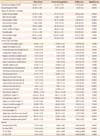1. Keim RG, Gottlieb EL, Nelson AH, Vogels DS 3rd. 2007 JCO orthodontic practice study. Part 1: Trends. J Clin Orthod. 2007; 41:617–626.
2. Proffit WR, Fields HW, Sarver DM. Contemporary orthodontics. St. Louis: Mosby;2007.
3. Farrow AL, Zarrinnia K, Azizi K. Bimaxillary protrusion in black Americans--an esthetic evaluation and the treatment considerations. Am J Orthod Dentofacial Orthop. 1993; 104:240–250.

4. Baek SH, Kim BH. Determinants of successful treatment of bimaxillary protrusion: orthodontic treatment versus anterior segmental osteotomy. J Craniofac Surg. 2005; 16:234–246.

5. Lee JK, Chung KR, Baek SH. Treatment outcomes of orthodontic treatment, corticotomy-assisted orthodontic treatment, and anterior segmental osteotomy for bimaxillary dentoalveolar protrusion. Plast Reconstr Surg. 2007; 120:1027–1036.

6. Park JU, Hwang YS. Evaluation of the soft and hard tissue changes after anterior segmental osteotomy on the maxilla and mandible. J Oral Maxillofac Surg. 2008; 66:98–103.

7. Sutter RE Jr, Turley PK. Soft tissue evaluation of contemporary Caucasian and African American female facial profiles. Angle Orthod. 1998; 68:487–496.
8. Islam R, Kitahara T, Naher L, Hara A, Nakasima A. Lip morphological changes in orthodontic treatment. Class II division 1: malocclusion and normal occlusion at rest and on smiling. Angle Orthod. 2009; 79:256–264.
9. Bisson M, Grobbelaar A. The esthetic properties of lips: a comparison of models and nonmodels. Angle Orthod. 2004; 74:162–166.
10. Kang YG, Lee YH, Kook YA, Kim SH, Sinclair PM. Comparison of the frontal esthetic preferences in the lower facial portion of Koreans and Caucasians. World J Orthod. 2009; 10:111–116.
11. Park NS, Park JH, Bayome M, Mo SS, Kim Y, Kook YA. An evaluation of preferred lip positions according to different age groups. Int J Oral Maxillofac Surg. 2013; 42:637–642.

12. Naini FB, Donaldson AN, McDonald F, Cobourne MT. Assessing the influence of lower facial profile convexity on perceived attractiveness in the orthognathic patient, clinician, and layperson. Oral Surg Oral Med Oral Pathol Oral Radiol. 2012; 114:303–311.

13. Fortes HN, Guimarães TC, Belo IM, da Matta EN. Photometric analysis of esthetically pleasant and unpleasant facial profile. Dental Press J Orthod. 2014; 19:66–75.

14. Mertens I, Siegmund H, Grüsser OJ. Gaze motor asymmetries in the perception of faces during a memory task. Neuropsychologia. 1993; 31:989–998.

15. Meyer-Marcotty P, Alpers GW, Gerdes AB, Stellzig-Eisenhauer A. Impact of facial asymmetry in visual perception: a 3-dimensional data analysis. Am J Orthod Dentofacial Orthop. 2010; 137:168.e1–168.e8.

16. Salehi P, Oshagh M, Aleyasin ZS, Pakshir HR. The effects of forehead and neck position on esthetics of class I, II and III profiles. Int J Esthet Dent. 2014; 9:412–425.
17. Row J, Rhu YK. A cephalometric analysis on facial esthetics of Korean young adult female. Korean J Orthod. 1988; 18:127–140.
18. Pettijohn TF 2nd, Jungeberg BJ. Playboy Playmate curves: changes in facial and body feature preferences across social and economic conditions. Pers Soc Psychol Bull. 2004; 30:1186–1197.

19. Pettijohn TF 2nd, Tesser A. Popularity in environmental context: Facial feature assessment of American movie actresses. Media Psychol. 1999; 1:229–247.

20. Nguyen DD, Turley PK. Changes in the Caucasian male facial profile as depicted in fashion magazines during the twentieth century. Am J Orthod Dentofacial Orthop. 1998; 114:208–217.

21. Auger TA, Turley PK. The female soft tissue profile as presented in fashion magazines during the 1900s: a photographic analysis. Int J Adult Orthodon Orthognath Surg. 1999; 14:7–18.
22. Zebrowitz LA, Tenenbaum DR, Goldstein LH. The impact of job applicants' facial maturity, sex, and academic achievement on hiring recommendations. J Appl Soc Psychol. 1991; 21:525–548.

23. Jones D, Loring Brace C, Jankowiak W, Laland KN, Musselman LE, Langlois JH, et al. Sexual selection, physical attractiveness, and facial neoteny: Cross-cultural evidence and implications. Curr Anthropol. 1995; 36:723–748.

24. Langlois JH, Kalakanis L, Rubenstein AJ, Larson A, Hallam M, Smoot M. Maxims or myths of beauty? A meta-analytic and theoretical review. Psychol Bull. 2000; 126:390–423.

25. Byrd-Bredbenner C, Murray J, Schlussel YR. Temporal changes in anthropometric measurements of idealized females and young women in general. Women Health. 2005; 41:13–30.

26. Farkas LG, Hreczko TA, Kolar JC, Munro IR. Vertical and horizontal proportions of the face in young adult North American Caucasians: revision of neoclassical canons. Plast Reconstr Surg. 1985; 75:328–338.
27. Ferrario VF, Sforza C, Poggio CE, Tartaglia G. Facial morphometry of television actresses compared with normal women. J Oral Maxillofac Surg. 1995; 53:1008–1014. discussion 1014-5

28. Sforza C, Dolci C, Grandi G, Tartaglia GM, Laino A, Ferrario VF. Comparison of soft-tissue orbital morphometry in attractive and normal Italian subjects. Angle Orthod. 2015; 85:127–133.

29. Mommaerts MY, Moerenhout BA. Ideal proportions in full face front view, contemporary versus antique. J Craniomaxillofac Surg. 2011; 39:107–110.

30. Austin HW, Weston GW. Rejuvenation of the aging mouth. Clin Plast Surg. 1992; 19:511–524.

31. An SM, Choi SY, Chung YW, Jang TH, Kang KH. Comparing esthetic smile perceptions among laypersons with and without orthodontic treatment experience and dentists. Korean J Orthod. 2014; 44:294–303.

32. Cha YM, Park NS, Bayome M, Han SH, Kim Y, Kook YA. The frontal soft tissue changes in the lower facial portion after orthodontic treatment combined with anterior segmental osteotomy. Orthodontics (Chic.). 2011; 12:232–241.
33. Denize ES, McDonald F, Sherriff M, Naini FB. Facial profile parameters and their relative influence on bilabial prominence and the perceptions of facial profile attractiveness: A novel approach. Korean J Orthod. 2014; 44:184–194.





 PDF
PDF ePub
ePub Citation
Citation Print
Print






 XML Download
XML Download